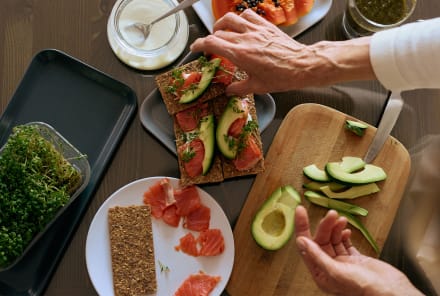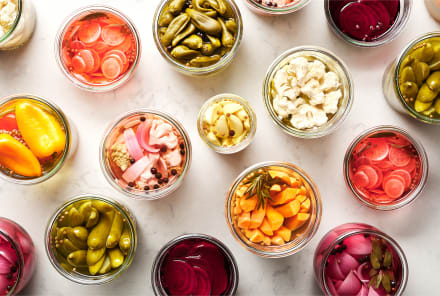Advertisement
The Truth About Sugar: How Much Is Too Much & How To Spot It On A Label


Now that we are out of the low-fat craze (more avocado, please!), attention has turned to sugar. The sweet stuff has been blamed for everything from the obesity epidemic to Alzheimer's disease1. And it's not all unwarranted. But wait, isn't this the same stuff that makes fruit taste so good? How can something in fruit be so bad for us? Well, it turns out, as with most things, moderation is key. Some sugar is OK, and some types of sugar are better than others.
Here, we answer all your questions about sugar, clearing up confusion about natural versus added sugar, how much is OK to eat, and how to spot it on a label.
Why do we need sugar?
First, a quick primer on what sugar is and why we need it. Sugar provides quick and easy energy in the diet, fueling daily activity and exercise. Three main macronutrients exist in food—protein, carbohydrates, and fat. Sugar is a carbohydrate and is naturally present in whole foods, but it is also added to many processed foods, like bread, pastries, ice cream, yogurt, soda, juice, condiments, and more.
Digestive enzymes present in the saliva and released into the small intestine help to break down carbohydrates (whether natural or added) into their simple sugars—glucose, galactose, and fructose. These simple sugars travel to the liver, and eventually, a certain amount of glucose is transported back into the bloodstream. The pancreas is then signaled to produce and release insulin, the hormone that is responsible for transporting glucose to cells for energy.
So, what's the harm in eating too much sugar?
Since carbohydrates are the fuel for activity, a sedentary lifestyle combined with high sugar intake (especially from sweetened beverages) that often leads to elevated blood sugar levels has been shown to promote:
Added sugar is often present even in foods you'd least expect, which can lead to overconsumption. The average American consumes about 17 teaspoons of added sugar7 or over 270 calories per day. Next time you bake a batch of cookies, think about this: 1 cup of sugar equals 773 calories! You could eat 12 cups of grapes for the same calories (with substantially more nutrients and water content)!
What is the deal with natural versus added sugar?
"Natural sugar" is sugar found in unprocessed, whole foods like fruit, dairy, and even whole grains. Some also consider honey, coconut sugar, and maple syrup natural sugars, though they do not contain the rich nutrients that whole foods contain. For this article, "natural sugar" refers only to whole food sources. "Added sugar" refers to when any form of sugar (including "natural" forms like honey, maple syrup, fruit concentrate, etc.) is added to a product during manufacturing and processing. Added sugar helps products to caramelize, preserves and extends shelf life, enables fermentation, and balances acidity in foods. The many uses of sugar explain why sugar is so prevalent in the food supply.
Regardless of the type of sugar that is consumed, eventually it is broken down into the same simple sugars—glucose, fructose, or galactose, with some amount of glucose returning to the bloodstream and eliciting the pancreas to produce insulin. This might lead some to believe that there is no difference between a gram of sugar from a piece of candy and a gram of sugar from a berry. However, don't be fooled. Natural sugar is regarded as the healthier form of sugar because it is wrapped in a whole food package with a nutrient-rich matrix that provides more than just sugar when consumed (antioxidants, phytochemicals, fiber, water, vitamins, and minerals, to name a few), slows down the absorption of the sugar so there is less demand on the pancreas for insulin, and provides satiety, helping to curb calorie intake later.
In the U.S., new label laws8 require added sugars to be listed on the nutrition facts panel to help you keep your sugar intake in check. You'll notice some food products have already adopted the new label voluntarily, but all manufacturers must comply by January 1, 20219. Keep reading to find out how else to spot sugar on food labels.
How much sugar is OK?
Many public health agencies such as the American Heart Association, the CDC10, the U.S. Department of Health and Human Services, and others recommend no more than 36 grams of added sugar for men per day and no more than 24 grams for women and children over 2 years of age. One teaspoon of sugar equals 4 grams, so you can easily do the math to see how your favorite food product compares to the recommendations.
The pace of weight loss or weight gain differs from individual to individual. Gender, age, activity level, hormone function, genetics, and more all play a role. That said, overconsuming carbohydrates in the form of added sugar is one of the easiest ways to gain weight for most people, especially if your exercise and daily activity do not match your carbohydrate intake. Reducing your added sugar consumption can help minimize your risk of obesity, diabetes, and cardiovascular disease, all of which are lifestyle-related leading causes of death in the U.S.
How do you reduce your sugar intake?
Looking to lower your sugar intake? Try one of these two strategies:
Gradual: Slowly cut back on sweetened foods.
You may find gradually reducing your sugar consumption is more practical and sustainable. Try sweetening foods yourself. This usually results in less sugar consumed than the presweetened versions available at grocery stores.
Snack on fruit when you want something sweet. Swap sugar-sweetened beverages for water, unsweetened tea, sparkling water, or black coffee.
Substitute calorie-containing added sugars for non-artificial sweeteners like erythritol and stevia until you can reduce all sweet foods and sweeteners (even the low-calorie and no-calorie ones)
Cold turkey: Eliminate all added sugars.
For this method, aim to eliminate all added sugars for seven to 10 days (or longer) to reset your palate and reduce your daily cravings for sweetness. Depend on naturally sweet fruits to help you through any cravings.
Sneaky names for sugar.
Serious about limiting your sugar intake? Sugar takes many forms and can sneak into your favorite foods, even healthy meals like salad, if you aren't vigilant. You can more easily spot sugar on an ingredient list if you look for words that include "syrup," "cane," "fructose," or "molasses." Also, keep an eye out for words ending in "-ose" or "‑ol."
Familiarize yourself with the list below to know exactly what to exclude:
- Agave Nectar
- Barbados Sugar
- Barley Malt
- Beet Sugar
- Brown Sugar
- Cane Crystals, Cane Juice Crystals, Cane Juice
- Caramel
- Carob Syrup or Sugar
- Coconut Nectar/Sugar
- Concentrated Fruit Juice
- Confectioner's Sugar
- Corn Syrup, Solids
- Corn Sweetener
- Crystalline Fructose
- Dextrin
- Diastatic Malt, Diatase
- Evaporated Cane Juice
- Florida Crystals
- Fruit Concentrate
- Glucose Solids
- Golden Sugar/Syrup
- Granulated Sugar
- Grape Sugar
- Grape Juice Concentrate
- High-Fructose Corn Syrup (HFCS)
- Honey
- Icing/Invert Sugar
- Lactose (added)
- Malt Syrup
- Maple Syrup
- Molasses
- Muscovado
- Nectresse
- Palm Sugar
- Refiner's Syrup
- Rice Syrup/Malt
- Sorghum Syrup
- Sugar/Raw Sugar
- Table Sugar
- Treacle
- Turbinado Sugar
- "-ol" sugars: erythritol, ethyl maltol, mannitol, sorbitol
- "-ose" sugars: dextrose, D-mannose, fructose, galactose, glucose, maltose, sucrose
While there is no need to completely ditch all forms of sugar, cutting back is probably a good idea. Try to focus on natural sugar from whole food sources to satisfy your sweet tooth without going overboard.
10 Sources
- https://link.springer.com/article/10.1007/s00125-017-4541-7
- https://www.ncbi.nlm.nih.gov/pubmed/31475413
- https://www.ncbi.nlm.nih.gov/pmc/articles/PMC5421126/
- https://www.ncbi.nlm.nih.gov/pubmed/17921363
- https://www.ncbi.nlm.nih.gov/pubmed/31443567
- https://www.ncbi.nlm.nih.gov/pubmed/26758380
- https://www.cdc.gov/nchs/fastats/diet.htm
- https://www.fda.gov/food/new-nutrition-facts-label/added-sugars-new-nutrition-facts-label
- https://www.fda.gov/food/food-labeling-nutrition/changes-nutrition-facts-label
- https://www.cdc.gov/nutrition/data-statistics/know-your-limit-for-added-sugars.html
Watch Next
Enjoy some of our favorite clips from classes
Enjoy some of our favorite clips from classes
What Is Meditation?
Mindfulness/Spirituality | Light Watkins
Box Breathing
Mindfulness/Spirituality | Gwen Dittmar
What Breathwork Can Address
Mindfulness/Spirituality | Gwen Dittmar
The 8 Limbs of Yoga - What is Asana?
Yoga | Caley Alyssa
Two Standing Postures to Open Up Tight Hips
Yoga | Caley Alyssa
How Plants Can Optimize Athletic Performance
Nutrition | Rich Roll
What to Eat Before a Workout
Nutrition | Rich Roll
How Ayurveda Helps Us Navigate Modern Life
Nutrition | Sahara Rose
Messages About Love & Relationships
Love & Relationships | Esther Perel
Love Languages
Love & Relationships | Esther Perel

















